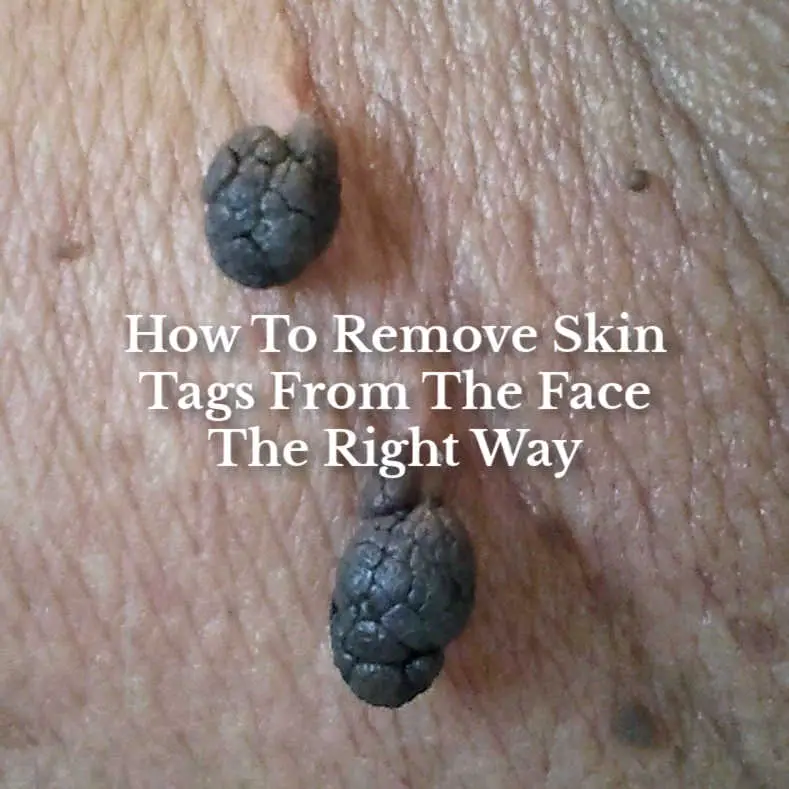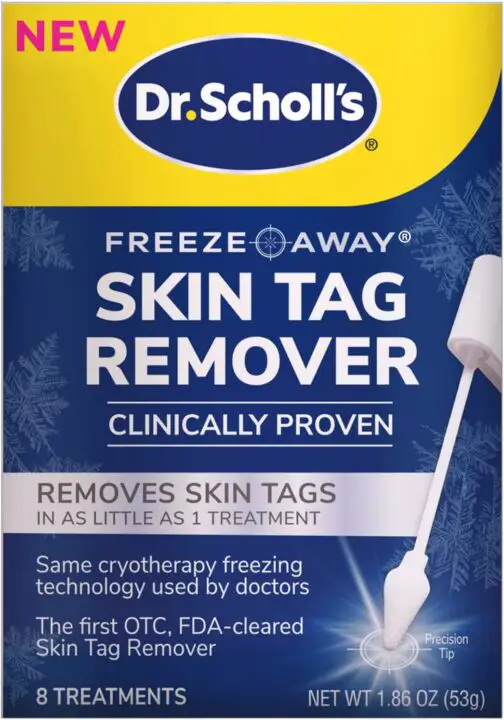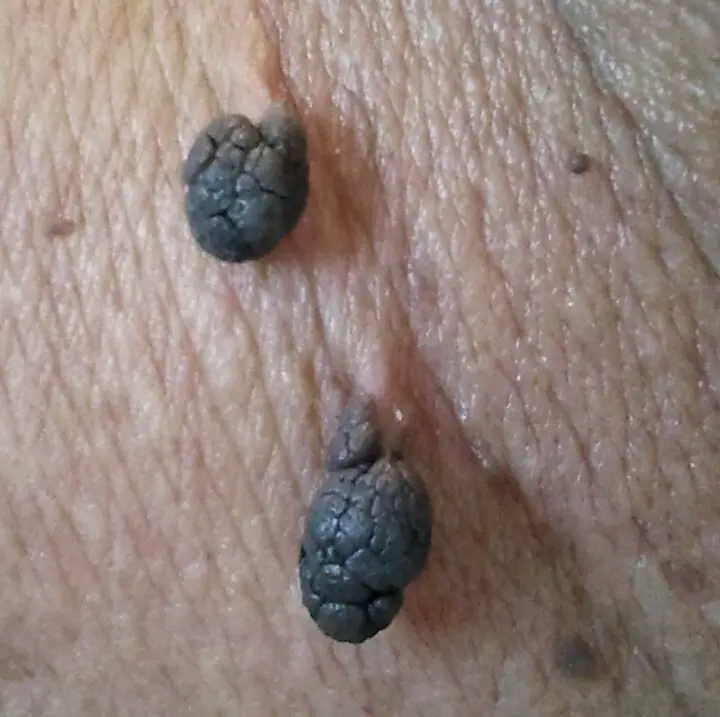
Back a few years ago I had a skin tag on my left upper cheek. Like an idiot, I didn’t want to spend the money to go to a dermatologist to get it removed so I sterilized a small, sharp scissors and just snipped it off. It bled for a while then stopped. I figured that would be the end of it.
I was wrong.
After the actual wound healed the area became hyper-pigmented: instead of a small skin tag I now had a much larger dark spot on my face. It took months of experimentation with various products to fade the discoloration.
(What finally worked for me? A combination of Bevel’s Glycolic Acid Toner Pads and OneBlade’s Daily Moisturizer With SPF. Affiliate links. “Your Mileage May Vary,” see below.)
If you are considering removing skin tags from your face, it is important to be aware of the risks involved in order to ensure a safe process. Here are some expert-recommended ways to remove skin tags on your face in the most safe and effective way possible.
The Best Way To Remove Skin Tags On The Face
I think it’s best to visit a doctor for skin tag removal. Although there are products available for removing moles, skin tags and other growths at home, none of them have received FDA approval. Trying to remove a mole or skin tag at home could cause a serious infection and uncontrolled bleeding that requires going to an emergency room or an urgent care center.
Visiting a dermatologist to get a skin tag removed has five main benefits:
- First, it allows the doctor to find and treat any skin cancer that may be present.
- Second, it can help to prevent further skin tags from appearing if you have a correlated health condition.
- Third, the doctor is experienced in safely and effectively removing skin tags.
- Fourth, they know how to minimize the risk of scarring or other damage.
- Finally, they can give you the best possible outcome.
For these reasons, I recommend seeking medical advice before attempting any home remedies for skin tag removal, such as applying apple cider vinegar, tea tree oil, wart remover, vitamin E cream, banana peels, garlic, or cutting it off with scissors/nail clippers.

Removal By A Doctor
Generally, there are three main methods to remove skin tags that professionals use:
1. Snipping: A doctor or dermatologist may snip off the skin tag with small, sterile scissors at the base of the stalk. If the skin tag is small enough they may do the procedure without numbing cream.
2. Electrocauterization: The doctor may use a heated electrical current to destroy the skin tag’s stalk or the skin tag itself.
3. Cryotherapy: Cryotherapy involves freezing the skin tag off. However, people of color or those who have a strong tendency to scar may experience hyperpigmentation.
Visiting a doctor is the safest and most effective way to remove skin tags on your face. They follow guidelines that reduce the risk of infection, minimize scarring, and prevent loss of movement due to scarring.
Furthermore, they are able to identify any underlying conditions or syndromes that may be causing the skin tags, as well as any cancerous spots that may need to be removed.
Finally, leaving behind microscopic cancer cells can occur if the spot removed is skin cancer and can spread quickly throughout the body. So it is important to visit a doctor to safely and effectively remove skin tags on your face.
Removal By Yourself
If you’re set on doing this yourself, for whatever reason, there are a number of ways to do it, with varying degrees of success.
The Wrong Ways to Remove Skin Tags Yourself
If you’re looking for ways to remove skin tags from your face yourself, it’s important to understand the wrong ways to do it. Trying to cut off a skin tag yourself at home is not recommended, as it is likely to lead to more headaches afterwards and can be dangerous, as I discovered for myself.
Apple cider vinegar is one of the most widely used home remedies, as it is said to be effective in removing tags. Soaking a cotton ball in vinegar and affixing it to the tag with a bandage for several hours is one way to use this method.
Massaging tea tree oil into the area around the skin tag can also help to remove them but this is unproven and can also potentially cause infection.
Tying string or dental floss around the skin tag to cut off the circulation is another at-home remedy. I’ve actually used this method successfully on a tag under my arm. But since you would have to keep it on for a week or so, you would look pretty silly with it on the face.
Are over-the-counter skin tag removal kits safe to use? While many people may want to try and remove skin tags themselves with products available over-the-counter, the evidence does not suggest that these products are effective, and in some cases, they may even cause skin irritation.

Freezing kits (like this one, Amazon affiliate link. Note that this product has only a 67% positive sentiment rating) can also be used to remove skin tags, however, it is important to note that these need to reach the appropriate temperature to work and can cause irritation or contact dermatitis.
After removing a skin tag at home, it is important to apply antibiotic ointment to the affected area and keep it covered with a bandage.
Are There Any Risks Associated With Skin Tag Removal?
While removing a skin tag on your own at home carries risks, including bleeding, infection, and scarring, having a professional do it can minimize these risks and ensure that the growth is not a more serious problem such as skin cancer.
It is always best to have a skin tag removed by a dermatologist in a sterile environment to minimize the risk of infection or complications.
FAQ
What Is A Skin Tag?
Skin tags are small, soft, normally benign growths on the skin that are connected to the surface of the skin by a thin stalk. They are usually flesh-colored (though this can vary), knobbly and hang off the skin, and do not usually cause any pain or discomfort. They can grow slowly or quickly depending on a variety of factors, including genetics and the amount of skin exposed to the sun.
If you notice any new growth on your skin, make sure to talk to your doctor or dermatologist about it.
What Causes Skin Tags?
The exact cause of skin tags is not known, though they seem to be more common in people who have diabetes or are overweight. Additionally, people over 40, especially those over 60, are more likely to develop skin tags.
Studies show that there may be a correlation between the human papillomavirus and skin tags, as well as with insulin resistance, which can lead to type 2 diabetes and prediabetes. According to a 2010 study, multiple skin tags were associated with insulin resistance, a high body mass index, and high triglycerides.
Skin tags are normally benign, and while they may become irritated or inflamed due to rubbing against clothing or jewelry, they are usually harmless and can be removed if they are bothersome.

Skin Tags Can Be A Risk Factor For Skin Cancer And Other Diseases
When it comes to removing skin tags on the face, it is important to be aware of the potential risks. Though skin tags are generally harmless and it is very rare for them to become cancerous, it is still important to have them checked out by a board-certified dermatologist if you notice any new or changing spots. This is because it can be difficult to differentiate between a skin tag and a cancerous growth without a professional opinion.
In addition, having a skin tag removed could potentially reveal an underlying genetic condition such as Acromegaly, Birt-Hogg-Dubé syndrome, and Cowden syndrome. For this reason, it is important to have the removed tag sent to a lab for further examination.
All in all, while removing skin tags from the face is generally safe, it is important to consult with a dermatologist first. This allows for a professional to examine the spot and differentiate between a harmless skin tag and something more serious. It also allows for the potential to uncover an underlying condition that may be causing the skin tag in the first place.
How To Avoid Recurrence Of Skin Tags On The Face
The best course of action for avoiding recurrence of skin tags on the face is to visit a dermatologist. A doctor can confirm if the lesion is a skin tag and then determine the best treatment option. The doctor may suggest cryotherapy, which involves freezing the skin tag using liquid nitrogen, or cauterization, which involves using heat or electrical current to burn the skin tag off. In some cases, the doctor may even recommend laser removal for more stubborn skin tags. Additionally, it is important to maintain a healthy weight, practice good skin care habits, and manage any underlying medical conditions to help minimize the risk of recurrence.
Staying at a healthy weight and engaging in self-care are important. Try to reduce any friction where a skin tag already exists by avoiding tight clothes, cushioning belts or straps that frequently rub in one area, or using an anti-chafing balm. Additionally, maintaining a well-balanced diet, exercising regularly, and taking vitamin E supplements can all help to keep the skin healthy and minimize skin tag occurrences. If you already have skin tags, it is important to seek medical advice and get help from a doctor or cosmetic surgeon to safely remove them.
Summing Up
Skin tags can be a nuisance on the face, especially if they appear in unwanted places. While they are harmless, many people choose to have them removed. But, take it from me, there is a right way and a wrong way to do it. Leave this to a professional.

thanks alot of information
Comments are closed.